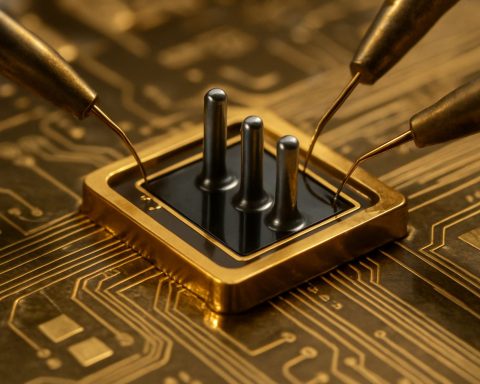- Intel’s stock surged over 24% in a week amid speculation of a partnership with Taiwan Semiconductor.
- The alliance could enhance industry influence but faces cultural and operational integration challenges.
- Intel’s manufacturing practices might conflict with Taiwan Semiconductor’s established protocols.
- Intel expands its market reach with key deals, including Amazon Web Services, showcasing versatility in chip manufacturing.
- Taiwan Semiconductor strengthens its U.S. presence and targets collaborations with firms like Nvidia.
- Experts suggest Intel may benefit from refocusing on its core strength in microprocessors.
- The semiconductor industry remains dynamic, with innovation and strategic partnerships driving success.
Intel’s stock prices have soared dramatically, jumping over 24% within just a week. The excitement stems from whispers of a possible alliance with Taiwan Semiconductor, a dominant force in the world of chip manufacturing. But not everyone is convinced this ambitious partnership will work smoothly.
The very idea of Intel joining forces with Taiwan Semiconductor tantalizes investors with visions of unparalleled industry clout. However, Intel’s ingrained manufacturing ethos and practical operations could clash headfirst with Taiwan Semiconductor’s established culture and production protocols. The transformation required would be monumental, akin to replanting a giant oak into foreign soil overnight.
Imagine a bustling factory in Taiwan where Intel’s workforce has to dismantle their longstanding strategies and adapt to an entirely new way of life. Employees might find themselves relocating to live steps away from their workstations, ready to meet demands at the drop of a hat—a daunting perspective for those accustomed to different work-life balances.
As these possibilities hang in the air, Intel continues to spread its wings by tapping into new markets. Impressively, it clinches deals with giants like Amazon Web Services, paving a path as a versatile chip manufacturer.
Meanwhile, Taiwan Semiconductor isn’t resting on its laurels. It solidifies its standing with a robust presence in Arizona and eyes opportunities with tech behemoths like Nvidia. In this rapidly evolving landscape, some experts suggest that Intel may find greater success by returning to its roots—focusing on microprocessors where its legacy shines brightest.
As the drama unfolds, one thing remains clear: The semiconductor industry is a thrilling arena of possibility, with every player striving to craft a narrative of success and innovation.
Why Intel’s Possible Partnership with Taiwan Semiconductor Has Investors Buzzing
How-To Steps & Life Hacks: Navigating Potential Cultural Clashes
1. Cultural Synergy: Facilitate cultural integration for Intel and Taiwan Semiconductor employees by implementing joint workshops and exchange programs. This helps blend the distinct corporate cultures and establish a cohesive working environment.
2. Adapting Strategies: Intel employees should be encouraged to learn and adapt to Taiwan Semiconductor’s production protocols through intensive training and mentorship programs.
3. Relocation Support: To assist employees relocating to Taiwan, provide comprehensive relocation packages, including housing and cultural orientation, to ease the transition.
Real-World Use Cases
– Innovative Product Development: Leveraging Taiwan Semiconductor’s advanced manufacturing prowess could accelerate Intel’s development of next-gen processors, enhancing performance for AI and machine learning applications.
– Market Diversification: Access to Taiwan Semiconductor’s clientele, including tech giants like Nvidia, could allow Intel to diversify its market reach, boosting competitiveness in sectors like automotive and consumer electronics.
Market Forecasts & Industry Trends
The semiconductor industry is set for robust growth, projected to reach $1 trillion by 2030 (source: McKinsey & Company). Trends indicate a surge in demand for chips in areas like AI, 5G, and IoT, suggesting a strategic collaboration could position both companies for significant market expansion.
Reviews & Comparisons
– Competing Giants: In comparison to rivals like AMD and Samsung, a partnership could significantly heighten Intel’s competitive edge, particularly if it enables advancements in manufacturing technologies and reductions in time-to-market.
Controversies & Limitations
– Cultural and Operational Disparities: Merging two distinct corporate cultures might lead to friction, delaying integration efforts and impacting productivity. The partnership risks strategic misalignments reflecting differing corporate visions.
Features, Specs & Pricing
– Advanced Node Development: Collaboration could focus on leveraging Taiwan Semiconductor’s advanced process nodes (3nm or even 2nm) to boost Intel’s CPU and GPU offerings, positioning them at the forefront of technological innovation.
Security & Sustainability
– Supply Chain Security: Being reliant on Taiwan Semiconductor could expose Intel to geopolitical tensions, risking supply chain disruptions. Possible mitigation includes diversifying production sites globally.
– Sustainability Initiatives: Both companies can pool resources to pioneer eco-friendly manufacturing processes, reducing carbon footprints in chip production.
Insights & Predictions
Experts predict that if successfully executed, the partnership could solidify Intel’s position as a leader in chip innovation. However, emphasis on communication and cultural integration will be critical to any future success.
Tutorials & Compatibility
– Training Platforms: Establish comprehensive bilingual training platforms to facilitate skill development for employees transitioning to new operational protocols.
Pros & Cons Overview
Pros:
– Enhanced technological capabilities and market reach
– Potential for accelerated innovation and time-to-market
Cons:
– Risk of cultural and operational mismatch
– Potential geopolitical vulnerabilities
Actionable Recommendations
– Stakeholder Engagement: Ensure active engagement with stakeholders at every integration phase to smoothen transitions and foster collaboration.
– Continuous Feedback Loop: Implement mechanisms for continuous employee feedback, allowing quick identification and resolution of cultural and operational challenges.
For more insights into the evolving semiconductor industry landscape, you might find these resources helpful: [Intel](https://www.intel.com), [Taiwan Semiconductor](https://www.tsmc.com).
The semiconductor industry is undoubtedly a thrilling narrative of innovation and strategic maneuvers. For Intel, the potential partnership with Taiwan Semiconductor isn’t just about expansion—it’s about redefining its legacy for the digital future.











